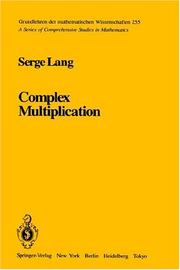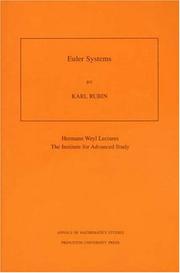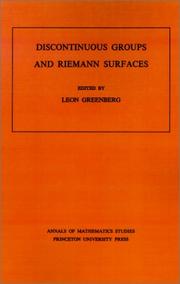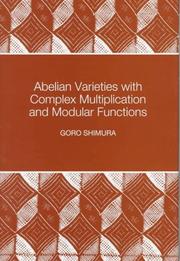| Listing 1 - 10 of 14 | << page >> |
Sort by
|
Book
ISBN: 9780511776892 9780521766685 9781107471771 9780511776199 0511776195 9780511773617 0511773617 0511776896 0521766680 1107208912 1139636669 1282651862 9786612651861 0511775431 0511772548 0511774672 110747177X 9781107208919 9781139636667 9781282651869 6612651865 9780511775437 9780511772542 9780511774676 Year: 2010 Publisher: Cambridge New York Cambridge University Press
Abstract | Keywords | Export | Availability | Bookmark
 Loading...
Loading...Choose an application
- Reference Manager
- EndNote
- RefWorks (Direct export to RefWorks)
This is a self-contained 2010 account of the state of the art in classical complex multiplication that includes recent results on rings of integers and applications to cryptography using elliptic curves. The author is exhaustive in his treatment, giving a thorough development of the theory of elliptic functions, modular functions and quadratic number fields and providing a concise summary of the results from class field theory. The main results are accompanied by numerical examples, equipping any reader with all the tools and formulas they need. Topics covered include: the construction of class fields over quadratic imaginary number fields by singular values of the modular invariant j and Weber's tau-function; explicit construction of rings of integers in ray class fields and Galois module structure; the construction of cryptographically relevant elliptic curves over finite fields; proof of Berwick's congruences using division values of the Weierstrass p-function; relations between elliptic units and class numbers.
Multiplication, Complex. --- Geometry, Algebraic. --- Algebraic geometry --- Geometry --- Complex multiplication --- Geometry, Algebraic
Book
ISBN: 3642006388 9786613562227 1280384301 3642006396 Year: 2009 Publisher: Berlin : Springer,
Abstract | Keywords | Export | Availability | Bookmark
 Loading...
Loading...Choose an application
- Reference Manager
- EndNote
- RefWorks (Direct export to RefWorks)
The main goal of this book is the construction of families of Calabi-Yau 3-manifolds with dense sets of complex multiplication fibers. The new families are determined by combining and generalizing two methods. Firstly, the method of E. Viehweg and K. Zuo, who have constructed a deformation of the Fermat quintic with a dense set of CM fibers by a tower of cyclic coverings. Using this method, new families of K3 surfaces with dense sets of CM fibers and involutions are obtained. Secondly, the construction method of the Borcea-Voisin mirror family, which in the case of the author's examples yields families of Calabi-Yau 3-manifolds with dense sets of CM fibers, is also utilized. Moreover fibers with complex multiplication of these new families are also determined. This book was written for young mathematicians, physicists and also for experts who are interested in complex multiplication and varieties with complex multiplication. The reader is introduced to generic Mumford-Tate groups and Shimura data, which are among the main tools used here. The generic Mumford-Tate groups of families of cyclic covers of the projective line are computed for a broad range of examples.
Geometry --- Mathematics --- Physical Sciences & Mathematics --- Calabi-Yau manifolds. --- Multiplication, Complex. --- Complex multiplication --- Mathematics. --- Algebraic geometry. --- Algebraic Geometry. --- Algebraic geometry --- Math --- Science --- Geometry, Algebraic --- Manifolds (Mathematics) --- Geometry, algebraic.
Book
ISBN: 3540189157 0387189157 3540388427 9783540189152 Year: 1988 Volume: 1301 13 Publisher: Berlin Springer
Abstract | Keywords | Export | Availability | Bookmark
 Loading...
Loading...Choose an application
- Reference Manager
- EndNote
- RefWorks (Direct export to RefWorks)
Algebraic geometry --- Hecke operators. --- Forms, Modular. --- Multiplication, Complex. --- 51 --- Hecke operators --- Forms, Modular --- Multiplication, Complex --- Complex multiplication --- Geometry, Algebraic --- Modular forms --- Forms (Mathematics) --- Operators, Hecke --- Operator theory --- Mathematics --- 51 Mathematics

ISBN: 0387907866 3540907866 1461254876 146125485X Year: 1983 Volume: vol 255 Publisher: New York (N.Y.): Springer
Abstract | Keywords | Export | Availability | Bookmark
 Loading...
Loading...Choose an application
- Reference Manager
- EndNote
- RefWorks (Direct export to RefWorks)
Multiplication, Complex --- 512.7 --- 514.74 --- Complex multiplication --- Geometry, Algebraic --- Algebraic geometry. Commutative rings and algebras --- Algebraic and analytic methods in geometry --- Multiplication, Complex. --- 514.74 Algebraic and analytic methods in geometry --- 512.7 Algebraic geometry. Commutative rings and algebras
Book
ISBN: 1280494654 9786613589880 1400842735 9781400842735 9780691154244 0691154244 9780691154251 0691154252 Year: 2012 Volume: 183 Publisher: Princeton, NJ
Abstract | Keywords | Export | Availability | Bookmark
 Loading...
Loading...Choose an application
- Reference Manager
- EndNote
- RefWorks (Direct export to RefWorks)
Mumford-Tate groups are the fundamental symmetry groups of Hodge theory, a subject which rests at the center of contemporary complex algebraic geometry. This book is the first comprehensive exploration of Mumford-Tate groups and domains. Containing basic theory and a wealth of new views and results, it will become an essential resource for graduate students and researchers. Although Mumford-Tate groups can be defined for general structures, their theory and use to date has mainly been in the classical case of abelian varieties. While the book does examine this area, it focuses on the nonclassical case. The general theory turns out to be very rich, such as in the unexpected connections of finite dimensional and infinite dimensional representation theory of real, semisimple Lie groups. The authors give the complete classification of Hodge representations, a topic that should become a standard in the finite-dimensional representation theory of noncompact, real, semisimple Lie groups. They also indicate that in the future, a connection seems ready to be made between Lie groups that admit discrete series representations and the study of automorphic cohomology on "ients of Mumford-Tate domains by arithmetic groups. Bringing together complex geometry, representation theory, and arithmetic, this book opens up a fresh perspective on an important subject.
Mumford-Tate groups. --- Geometry, Algebraic. --- Algebraic geometry --- Geometry --- Hodge theory --- Mumford-Tate groups --- Deligne torus integer. --- Galois group. --- Grothendieck conjecture. --- Hodge decomposition. --- Hodge domain. --- Hodge filtration. --- Hodge orientation. --- Hodge representation. --- Hodge structure. --- Hodge tensor. --- Hodge theory. --- Kubota rank. --- Lie algebra representation. --- Lie group. --- Mumford-Tate domain. --- Mumford-Tate group. --- Mumford-Tate subdomain. --- Noether-Lefschetz locus. --- Vogan diagram method. --- Weyl group. --- abelian variety. --- absolute Hodge class. --- algebraic geometry. --- arithmetic group. --- automorphic cohomology. --- classical group. --- compact dual. --- complex manifold. --- complex multiplication Hodge structure. --- complex multiplication. --- endomorphism algebra. --- exceptional group. --- holomorphic mapping. --- homogeneous complex manifold. --- homomorphism. --- mixed Hodge structure. --- moduli space. --- monodromy group. --- natural symmetry group. --- oriented imaginary number fields. --- period domain. --- period map. --- polarization. --- polarized Hodge structure. --- pure Hodge structure. --- reflex field. --- semisimple Lie algebra. --- semisimple Lie group. --- Γ-equivalence classes.

ISBN: 0691050759 1400865204 9781400865208 0691050767 9780691050768 9780691050751 9780691050768 Year: 2014 Publisher: Princeton, NJ
Abstract | Keywords | Export | Availability | Bookmark
 Loading...
Loading...Choose an application
- Reference Manager
- EndNote
- RefWorks (Direct export to RefWorks)
One of the most exciting new subjects in Algebraic Number Theory and Arithmetic Algebraic Geometry is the theory of Euler systems. Euler systems are special collections of cohomology classes attached to p-adic Galois representations. Introduced by Victor Kolyvagin in the late 1980's in order to bound Selmer groups attached to p-adic representations, Euler systems have since been used to solve several key problems. These include certain cases of the Birch and Swinnerton-Dyer Conjecture and the Main Conjecture of Iwasawa Theory. Because Selmer groups play a central role in Arithmetic Algebraic Geometry, Euler systems should be a powerful tool in the future development of the field. Here, in the first book to appear on the subject, Karl Rubin presents a self-contained development of the theory of Euler systems. Rubin first reviews and develops the necessary facts from Galois cohomology. He then introduces Euler systems, states the main theorems, and develops examples and applications. The remainder of the book is devoted to the proofs of the main theorems as well as some further speculations. The book assumes a solid background in algebraic Number Theory, and is suitable as an advanced graduate text. As a research monograph it will also prove useful to number theorists and researchers in Arithmetic Algebraic Geometry.
Algebraic number theory. --- p-adic numbers. --- Numbers, p-adic --- Number theory --- p-adic analysis --- Galois cohomology --- Cohomologie galoisienne. --- Algebraic number theory --- p-adic numbers --- Abelian extension. --- Abelian variety. --- Absolute Galois group. --- Algebraic closure. --- Barry Mazur. --- Big O notation. --- Birch and Swinnerton-Dyer conjecture. --- Cardinality. --- Class field theory. --- Coefficient. --- Cohomology. --- Complex multiplication. --- Conjecture. --- Corollary. --- Cyclotomic field. --- Dimension (vector space). --- Divisibility rule. --- Eigenvalues and eigenvectors. --- Elliptic curve. --- Error term. --- Euler product. --- Euler system. --- Exact sequence. --- Existential quantification. --- Field of fractions. --- Finite set. --- Functional equation. --- Galois cohomology. --- Galois group. --- Galois module. --- Gauss sum. --- Global field. --- Heegner point. --- Ideal class group. --- Integer. --- Inverse limit. --- Inverse system. --- Karl Rubin. --- Local field. --- Mathematical induction. --- Maximal ideal. --- Modular curve. --- Modular elliptic curve. --- Natural number. --- Orthogonality. --- P-adic number. --- Pairing. --- Principal ideal. --- R-factor (crystallography). --- Ralph Greenberg. --- Remainder. --- Residue field. --- Ring of integers. --- Scientific notation. --- Selmer group. --- Subgroup. --- Tate module. --- Taylor series. --- Tensor product. --- Theorem. --- Upper and lower bounds. --- Victor Kolyvagin. --- Courbes elliptiques --- Nombres, Théorie des
Book
Year: 2015 Publisher: Princeton, NJ : Princeton University Press,
Abstract | Keywords | Export | Availability | Bookmark
 Loading...
Loading...Choose an application
- Reference Manager
- EndNote
- RefWorks (Direct export to RefWorks)
This lavishly illustrated book provides a hands-on, step-by-step introduction to the intriguing mathematics of symmetry. Instead of breaking up patterns into blocks-a sort of potato-stamp method-Frank Farris offers a completely new waveform approach that enables you to create an endless variety of rosettes, friezes, and wallpaper patterns: dazzling art images where the beauty of nature meets the precision of mathematics.Featuring more than 100 stunning color illustrations and requiring only a modest background in math, Creating Symmetry begins by addressing the enigma of a simple curve, whose curious symmetry seems unexplained by its formula. Farris describes how complex numbers unlock the mystery, and how they lead to the next steps on an engaging path to constructing waveforms. He explains how to devise waveforms for each of the 17 possible wallpaper types, and then guides you through a host of other fascinating topics in symmetry, such as color-reversing patterns, three-color patterns, polyhedral symmetry, and hyperbolic symmetry. Along the way, Farris demonstrates how to marry waveforms with photographic images to construct beautiful symmetry patterns as he gradually familiarizes you with more advanced mathematics, including group theory, functional analysis, and partial differential equations. As you progress through the book, you'll learn how to create breathtaking art images of your own.Fun, accessible, and challenging, Creating Symmetry features numerous examples and exercises throughout, as well as engaging discussions of the history behind the mathematics presented in the book.
Symmetry (Mathematics) --- Symmetry (Art) --- Abstract algebra. --- Addition. --- Algorithm. --- Antisymmetry. --- Arc length. --- Boundary value problem. --- Cartesian coordinate system. --- Circular motion. --- Circumference. --- Coefficient. --- Complex analysis. --- Complex multiplication. --- Complex number. --- Complex plane. --- Computation. --- Coordinate system. --- Coset. --- Cyclic group. --- Derivative. --- Diagonal. --- Diagram (category theory). --- Dihedral group. --- Division by zero. --- Domain coloring. --- Dot product. --- Eigenfunction. --- Eigenvalues and eigenvectors. --- Eisenstein integer. --- Epicycloid. --- Equation. --- Euler's formula. --- Even and odd functions. --- Exponential function. --- Fourier series. --- Frieze group. --- Function (mathematics). --- Function composition. --- Function space. --- Gaussian integer. --- Geometry. --- Glide reflection. --- Group (mathematics). --- Group theory. --- Homomorphism. --- Horocycle. --- Hyperbolic geometry. --- Ideal point. --- Integer. --- Lattice (group). --- Linear interpolation. --- Local symmetry. --- M. C. Escher. --- Main diagonal. --- Mathematical proof. --- Mathematical structure. --- Mathematics. --- Mirror symmetry (string theory). --- Mirror symmetry. --- Morphing. --- Natural number. --- Normal subgroup. --- Notation. --- Ordinary differential equation. --- Parallelogram. --- Parametric equation. --- Parametrization. --- Periodic function. --- Plane symmetry. --- Plane wave. --- Point group. --- Polynomial. --- Power series. --- Projection (linear algebra). --- Pythagorean triple. --- Quantity. --- Quotient group. --- Real number. --- Reciprocal lattice. --- Rectangle. --- Reflection symmetry. --- Right angle. --- Ring of integers. --- Rotational symmetry. --- Scientific notation. --- Special case. --- Square lattice. --- Subgroup. --- Summation. --- Symmetry group. --- Symmetry. --- Tetrahedron. --- Theorem. --- Translational symmetry. --- Trigonometric functions. --- Unique factorization domain. --- Unit circle. --- Variable (mathematics). --- Vector space. --- Wallpaper group. --- Wave packet. --- Abstract algebra. --- Addition. --- Algorithm. --- Antisymmetry. --- Arc length. --- Boundary value problem. --- Cartesian coordinate system. --- Circular motion. --- Circumference. --- Coefficient. --- Complex analysis. --- Complex multiplication. --- Complex number. --- Complex plane. --- Computation. --- Coordinate system. --- Coset. --- Cyclic group. --- Derivative. --- Diagonal. --- Diagram (category theory). --- Dihedral group. --- Division by zero. --- Domain coloring. --- Dot product. --- Eigenfunction. --- Eigenvalues and eigenvectors. --- Eisenstein integer. --- Epicycloid. --- Equation. --- Euler's formula. --- Even and odd functions. --- Exponential function. --- Fourier series. --- Frieze group. --- Function (mathematics). --- Function composition. --- Function space. --- Gaussian integer. --- Geometry. --- Glide reflection. --- Group (mathematics). --- Group theory. --- Homomorphism. --- Horocycle. --- Hyperbolic geometry. --- Ideal point. --- Integer. --- Lattice (group). --- Linear interpolation. --- Local symmetry. --- M. C. Escher. --- Main diagonal. --- Mathematical proof. --- Mathematical structure. --- Mathematics. --- Mirror symmetry (string theory). --- Mirror symmetry. --- Morphing. --- Natural number. --- Normal subgroup. --- Notation. --- Ordinary differential equation. --- Parallelogram. --- Parametric equation. --- Parametrization. --- Periodic function. --- Plane symmetry. --- Plane wave. --- Point group. --- Polynomial. --- Power series. --- Projection (linear algebra). --- Pythagorean triple. --- Quantity. --- Quotient group. --- Real number. --- Reciprocal lattice. --- Rectangle. --- Reflection symmetry. --- Right angle. --- Ring of integers. --- Rotational symmetry. --- Scientific notation. --- Special case. --- Square lattice. --- Subgroup. --- Summation. --- Symmetry group. --- Symmetry. --- Tetrahedron. --- Theorem. --- Translational symmetry. --- Trigonometric functions. --- Unique factorization domain. --- Unit circle. --- Variable (mathematics). --- Vector space. --- Wallpaper group. --- Wave packet.

ISBN: 069108081X 9781400822492 1400822491 9780691080819 Year: 1971 Volume: 66 Publisher: Princeton, N.J. Princeton University Press
Abstract | Keywords | Export | Availability | Bookmark
 Loading...
Loading...Choose an application
- Reference Manager
- EndNote
- RefWorks (Direct export to RefWorks)
Intended for researchers in Riemann surfaces, this volume summarizes a significant portion of the work done in the field during the years 1966 to 1971.
Riemann surfaces --- Mathematics --- Physical Sciences & Mathematics --- Calculus --- Surfaces, Riemann --- Functions --- Congresses --- Differential geometry. Global analysis --- RIEMANN SURFACES --- congresses --- Congresses. --- MATHEMATICS / Calculus. --- Affine space. --- Algebraic function field. --- Algebraic structure. --- Analytic continuation. --- Analytic function. --- Analytic set. --- Automorphic form. --- Automorphic function. --- Automorphism. --- Beltrami equation. --- Bernhard Riemann. --- Boundary (topology). --- Canonical basis. --- Cartesian product. --- Clifford's theorem. --- Cohomology. --- Commutative diagram. --- Commutative property. --- Complex multiplication. --- Conformal geometry. --- Conformal map. --- Coset. --- Degeneracy (mathematics). --- Diagram (category theory). --- Differential geometry of surfaces. --- Dimension (vector space). --- Dirichlet boundary condition. --- Eigenfunction. --- Eigenvalues and eigenvectors. --- Eisenstein series. --- Euclidean space. --- Existential quantification. --- Explicit formulae (L-function). --- Exterior (topology). --- Finsler manifold. --- Fourier series. --- Fuchsian group. --- Function (mathematics). --- Generating set of a group. --- Group (mathematics). --- Hilbert space. --- Holomorphic function. --- Homeomorphism. --- Homology (mathematics). --- Homotopy. --- Hyperbolic geometry. --- Hyperbolic group. --- Identity matrix. --- Infimum and supremum. --- Inner automorphism. --- Intersection (set theory). --- Intersection number (graph theory). --- Isometry. --- Isomorphism class. --- Isomorphism theorem. --- Kleinian group. --- Limit point. --- Limit set. --- Linear map. --- Lorentz group. --- Mapping class group. --- Mathematical induction. --- Mathematics. --- Matrix (mathematics). --- Matrix multiplication. --- Measure (mathematics). --- Meromorphic function. --- Metric space. --- Modular group. --- Möbius transformation. --- Number theory. --- Osgood curve. --- Parity (mathematics). --- Partial isometry. --- Poisson summation formula. --- Pole (complex analysis). --- Projective space. --- Quadratic differential. --- Quadratic form. --- Quasiconformal mapping. --- Quotient space (linear algebra). --- Quotient space (topology). --- Riemann mapping theorem. --- Riemann sphere. --- Riemann surface. --- Riemann zeta function. --- Scalar multiplication. --- Scientific notation. --- Selberg trace formula. --- Series expansion. --- Sign (mathematics). --- Square-integrable function. --- Subgroup. --- Teichmüller space. --- Theorem. --- Topological manifold. --- Topological space. --- Uniformization. --- Unit disk. --- Variable (mathematics). --- Riemann, Surfaces de --- RIEMANN SURFACES - congresses --- Fonctions d'une variable complexe --- Surfaces de riemann

ISBN: 0691081387 1400881641 9780691081380 Year: 1974 Volume: 79 Publisher: Princeton, N.J.
Abstract | Keywords | Export | Availability | Bookmark
 Loading...
Loading...Choose an application
- Reference Manager
- EndNote
- RefWorks (Direct export to RefWorks)
Study 79 contains a collection of papers presented at the Conference on Discontinuous Groups and Ricmann Surfaces at the University of Maryland, May 21-25, 1973. The papers, by leading authorities, deal mainly with Fuchsian and Kleinian groups, Teichmüller spaces, Jacobian varieties, and quasiconformal mappings. These topics are intertwined, representing a common meeting of algebra, geometry, and analysis.
Group theory --- Complex analysis --- Number theory --- RIEMANN SURFACES --- Discontinuous groups --- congresses --- Congresses --- Riemann surfaces --- Congresses. --- Groupes discontinus --- Combinatorial topology --- Functions of complex variables --- Surfaces, Riemann --- Functions --- Abelian variety. --- Adjunction (field theory). --- Affine space. --- Algebraic curve. --- Algebraic structure. --- Analytic function. --- Arithmetic genus. --- Automorphism. --- Bernhard Riemann. --- Boundary (topology). --- Cauchy sequence. --- Cauchy–Schwarz inequality. --- Cayley–Hamilton theorem. --- Closed geodesic. --- Combination. --- Commutative diagram. --- Commutator subgroup. --- Compact Riemann surface. --- Complex dimension. --- Complex manifold. --- Complex multiplication. --- Complex space. --- Complex torus. --- Congruence subgroup. --- Conjugacy class. --- Convex set. --- Cyclic group. --- Degeneracy (mathematics). --- Diagram (category theory). --- Diffeomorphism. --- Differential form. --- Dimension (vector space). --- Disjoint sets. --- E7 (mathematics). --- Endomorphism. --- Equation. --- Equivalence class. --- Euclidean space. --- Existence theorem. --- Existential quantification. --- Finite group. --- Finitely generated group. --- Fuchsian group. --- Fundamental domain. --- Fundamental lemma (Langlands program). --- Fundamental polygon. --- Galois extension. --- Holomorphic function. --- Homeomorphism. --- Homology (mathematics). --- Homomorphism. --- Hurwitz's theorem (number theory). --- Inclusion map. --- Inequality (mathematics). --- Inner automorphism. --- Intersection (set theory). --- Irreducibility (mathematics). --- Isomorphism class. --- Isomorphism theorem. --- Jacobian variety. --- Jordan curve theorem. --- Kleinian group. --- Limit point. --- Mapping class group. --- Metric space. --- Monodromy. --- Monomorphism. --- Möbius transformation. --- Non-Euclidean geometry. --- Orthogonal trajectory. --- Permutation. --- Polynomial. --- Power series. --- Projective variety. --- Quadratic differential. --- Quadric. --- Quasi-projective variety. --- Quasiconformal mapping. --- Quotient space (topology). --- Rectangle. --- Riemann mapping theorem. --- Riemann surface. --- Schwarzian derivative. --- Simply connected space. --- Simultaneous equations. --- Special case. --- Subgroup. --- Subsequence. --- Surjective function. --- Symmetric space. --- Tangent space. --- Teichmüller space. --- Theorem. --- Topological space. --- Topology. --- Uniqueness theorem. --- Unit disk. --- Variable (mathematics). --- Winding number. --- Word problem (mathematics). --- RIEMANN SURFACES - congresses --- Discontinuous groups - Congresses --- Geometrie algebrique --- Fonctions d'une variable complexe --- Surfaces de riemann

ISBN: 0691016569 1400883946 9780691016566 Year: 1998 Volume: 46 Publisher: Princeton, N.J. Princeton University Press
Abstract | Keywords | Export | Availability | Bookmark
 Loading...
Loading...Choose an application
- Reference Manager
- EndNote
- RefWorks (Direct export to RefWorks)
Reciprocity laws of various kinds play a central role in number theory. In the easiest case, one obtains a transparent formulation by means of roots of unity, which are special values of exponential functions. A similar theory can be developed for special values of elliptic or elliptic modular functions, and is called complex multiplication of such functions. In 1900 Hilbert proposed the generalization of these as the twelfth of his famous problems. In this book, Goro Shimura provides the most comprehensive generalizations of this type by stating several reciprocity laws in terms of abelian varieties, theta functions, and modular functions of several variables, including Siegel modular functions. This subject is closely connected with the zeta function of an abelian variety, which is also covered as a main theme in the book. The third topic explored by Shimura is the various algebraic relations among the periods of abelian integrals. The investigation of such algebraicity is relatively new, but has attracted the interest of increasingly many researchers. Many of the topics discussed in this book have not been covered before. In particular, this is the first book in which the topics of various algebraic relations among the periods of abelian integrals, as well as the special values of theta and Siegel modular functions, are treated extensively.
Ordered algebraic structures --- 512.74 --- Abelian varieties --- Modular functions --- Functions, Modular --- Elliptic functions --- Group theory --- Number theory --- Varieties, Abelian --- Geometry, Algebraic --- Algebraic groups. Abelian varieties --- 512.74 Algebraic groups. Abelian varieties --- Abelian varieties. --- Modular functions. --- Abelian extension. --- Abelian group. --- Abelian variety. --- Absolute value. --- Adele ring. --- Affine space. --- Affine variety. --- Algebraic closure. --- Algebraic equation. --- Algebraic extension. --- Algebraic number field. --- Algebraic structure. --- Algebraic variety. --- Analytic manifold. --- Automorphic function. --- Automorphism. --- Big O notation. --- CM-field. --- Characteristic polynomial. --- Class field theory. --- Coefficient. --- Complete variety. --- Complex conjugate. --- Complex multiplication. --- Complex number. --- Complex torus. --- Corollary. --- Degenerate bilinear form. --- Differential form. --- Direct product. --- Direct proof. --- Discrete valuation ring. --- Divisor. --- Eigenvalues and eigenvectors. --- Embedding. --- Endomorphism. --- Existential quantification. --- Field of fractions. --- Finite field. --- Fractional ideal. --- Function (mathematics). --- Fundamental theorem. --- Galois extension. --- Galois group. --- Galois theory. --- Generic point. --- Ground field. --- Group theory. --- Groupoid. --- Hecke character. --- Homology (mathematics). --- Homomorphism. --- Identity element. --- Integer. --- Irreducibility (mathematics). --- Irreducible representation. --- Lie group. --- Linear combination. --- Linear subspace. --- Local ring. --- Modular form. --- Natural number. --- Number theory. --- Polynomial. --- Prime factor. --- Prime ideal. --- Projective space. --- Projective variety. --- Rational function. --- Rational mapping. --- Rational number. --- Real number. --- Residue field. --- Riemann hypothesis. --- Root of unity. --- Scientific notation. --- Semisimple algebra. --- Simple algebra. --- Singular value. --- Special case. --- Subgroup. --- Subring. --- Subset. --- Summation. --- Theorem. --- Vector space. --- Zero element.
| Listing 1 - 10 of 14 | << page >> |
Sort by
|

 Search
Search Feedback
Feedback About UniCat
About UniCat  Help
Help News
News